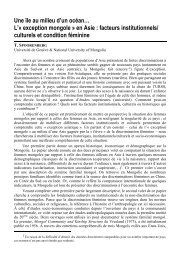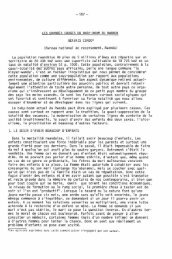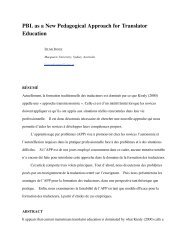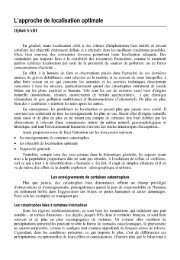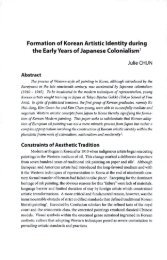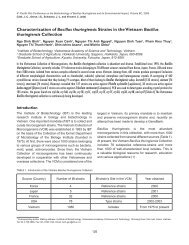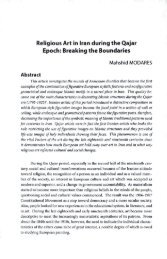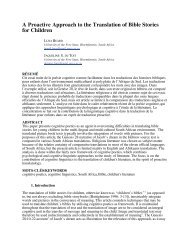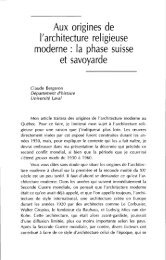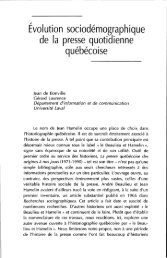Utilization of Bacillus thuringiensis var. israelensis (Bti)-Based ...
Utilization of Bacillus thuringiensis var. israelensis (Bti)-Based ...
Utilization of Bacillus thuringiensis var. israelensis (Bti)-Based ...
Create successful ePaper yourself
Turn your PDF publications into a flip-book with our unique Google optimized e-Paper software.
6 th Pacific Rim Conference on the Biotechnology <strong>of</strong> <strong>Bacillus</strong> <strong>thuringiensis</strong> and its Environmental Impact, Victoria BC, 2005<br />
Côté, J.-C., Otvos, I.S, Schwartz, J.-L. and Vincent, C. (eds)<br />
<strong>Utilization</strong> <strong>of</strong> <strong>Bacillus</strong> <strong>thuringiensis</strong> <strong>var</strong>. <strong>israelensis</strong> (<strong>Bti</strong>)-<strong>Based</strong> Formulations for<br />
the Biological Control <strong>of</strong> Mosquitoes in Canada<br />
Mario Boisvert 1 *<br />
Société de Protection des Forêts contre les Insectes et Maladies, Québec, QC, Canada, G1N 4B8<br />
Keywords: <strong>Bacillus</strong> <strong>thuringiensis</strong> <strong>israelensis</strong>, efficacy, mode <strong>of</strong> action, mosquitoes, safety, vectors.<br />
Since the discovery <strong>of</strong> <strong>Bacillus</strong> <strong>thuringiensis</strong> <strong>var</strong>. <strong>israelensis</strong> (<strong>Bti</strong>) in 1976, extensive literature has proven its efficacy to control mosquitoes, <strong>of</strong> which<br />
many species are known as important vectors <strong>of</strong> diseases or simply as pests <strong>of</strong> humans and animals. In an outbreak <strong>of</strong> illness, caused for example by<br />
West Nile virus, a mosquito-borne virus, the utilization <strong>of</strong> <strong>Bti</strong>-based products is one <strong>of</strong> the safest and most efficient method to control larval mosquito<br />
populations. The very specific and target-oriented mode <strong>of</strong> action <strong>of</strong> <strong>Bti</strong> makes it very safe for human health and non-target organisms. <strong>Bti</strong>-based<br />
products, distributed in different types <strong>of</strong> formulations, are utilized in many countries. Liquid and granular formulations are used in Canada for<br />
more than 20 years to control mosquitoes in pest control programs (either in cold or warm water conditions) and since 2003 in West Nile virus<br />
control programs. Although recognized for its high efficacy, <strong>Bti</strong>-based formulations may be affected by «mosquito» and «environmental» parameters.<br />
However, considering the high efficacy, specificity, long shelf life <strong>of</strong> <strong>Bti</strong>-based products, these should be considered first when prophylactic or regular<br />
mosquito control programs would be required.<br />
Introduction<br />
Since the discovery <strong>of</strong> <strong>Bacillus</strong> <strong>thuringiensis</strong> <strong>var</strong>.<br />
<strong>israelensis</strong> (<strong>Bti</strong>) in 1976, extensive literature has proven<br />
its efficacy to control mosquitoes and black flies, <strong>of</strong><br />
which many species are known as important vectors <strong>of</strong><br />
diseases or simply as pests <strong>of</strong> humans and animals.<br />
So, considering that the <strong>Bti</strong> high efficacy has already<br />
been proven by many papers in the last 20 years, this<br />
paper will put more emphasis (like a review article) on<br />
topics like the mode <strong>of</strong> action, elements (mosquito and<br />
environmental parameters) affecting its efficacy, fate<br />
in the environment, innocuousness and environmental<br />
safety for a better understanding <strong>of</strong> this microbial<br />
insecticide. But in a first time, a brief presentation <strong>of</strong> the<br />
mosquitoes which are one <strong>of</strong> main target <strong>of</strong> the <strong>Bti</strong> will<br />
be made.<br />
Mosquitoes<br />
Mosquitoes are vectors <strong>of</strong> many diseases around the<br />
world like malaria, dengue fever, yellow fever and many<br />
types <strong>of</strong> encephalitis. Since 1999 in United States and<br />
2001 in Canada, the West Nile virus is now present in<br />
both countries and has infected thousands <strong>of</strong> people in<br />
the last six years with unfortunately many fatalities.<br />
In United States and many provinces in Canada,<br />
adulticides are used to control mosquito populations,<br />
but larvicides like <strong>Bti</strong> are also commonly used. In the<br />
* Mailing address : SOPFIM,1780, rue Semple,Québec (Québec),Canada, G1N 4B8. Tel. : 418 681 3381. Fax.: 418 681 0994. Email : m.boisvert@sopfim.qc.ca<br />
87<br />
province <strong>of</strong> Québec (Canada), almost 100 % <strong>of</strong> the<br />
products used in the last 20 years to control mosquitoes<br />
and black flies contained <strong>Bti</strong>. This type <strong>of</strong> insecticide is<br />
called «larvicide» and acts only on the larval stages <strong>of</strong><br />
target organisms.<br />
Figure 1 represents the life cycle <strong>of</strong> mosquitoes.<br />
Depending <strong>of</strong> the species, the adult female will lay eggs<br />
either on the water surface (egg rafts or single eggs)<br />
or on damp soil (single eggs). In favourable conditions,<br />
eggs will hatch and give birth to larvae. There are four<br />
different larval instars. The last aquatic stage is the<br />
pupa from which will emerge the adult. <strong>Bti</strong> is active only<br />
against the larvae (see mode <strong>of</strong> action) and there is no<br />
toxic activity neither against the eggs or the pupae.<br />
Mosquitoes can breed in many types <strong>of</strong> habitats. One<br />
can find them in roadside and irrigation ditches, pastures,<br />
woodland pools, tidal waters, salt marshes, polluted waters<br />
(with organic and/or inorganic matter), small containers,<br />
tires and tree holes. They are also present in your own<br />
backyard in abandoned pools, bird baths, ro<strong>of</strong>s, clogged<br />
gutters, etc. Almost everywhere where stagnant waters<br />
are present, you get high probabilities to find mosquito<br />
larvae. Different formulations <strong>of</strong> <strong>Bti</strong> can be used to<br />
control larvae in these <strong>var</strong>ious breeding sites. The type <strong>of</strong><br />
formulations and dosages must be adjusted to the types<br />
<strong>of</strong> sites encountered. Factors affecting the efficacy <strong>of</strong> <strong>Bti</strong> in<br />
these environments will be discussed later.
Introduction to <strong>Bti</strong><br />
For the past six decades, humans have been almost<br />
completely dependent upon synthetic organic<br />
insecticides for agriculture, forestry and vector control<br />
purposes. However, the properties that made these<br />
chemicals useful - long residual action and toxicity for<br />
a wide spectrum <strong>of</strong> organisms - have brought about<br />
serious environmental problems and many concerns<br />
in the population. The emergence and spread <strong>of</strong><br />
insecticide resistance in many species <strong>of</strong> vectors, the<br />
concern with environmental pollution, and the high cost<br />
<strong>of</strong> the new chemical insecticides made it apparent that<br />
insect pest control could no longer be safely dependent<br />
upon the utilization <strong>of</strong> chemicals.<br />
In the mid-1970s, the World Health Organization (WHO)<br />
and other international institutions initiated studies on<br />
the development <strong>of</strong> existing and new biological control<br />
agents. In Israel, during the years 1975 and 1976,<br />
an extensive survey <strong>of</strong> mosquito breeding sites was<br />
launched to find natural pathogens and parasites <strong>of</strong><br />
mosquitoes. As a result <strong>of</strong> this effort a new mosquito<br />
pathogen was isolated from a stagnant pond located in<br />
the Negev Desert <strong>of</strong> Israel (Goldberg & Margalit, 1977).<br />
Bioassays performed by these researchers indicated<br />
that species in four genera <strong>of</strong> mosquitoes (Anopheles,<br />
Uranotaenia, Culex and Aedes) were susceptible. This<br />
bacterium was identified as being in the genus <strong>Bacillus</strong><br />
and its pathogenicity was initially (erroneously) attributed<br />
to its spores. Details <strong>of</strong> the discovery and properties<br />
<strong>of</strong> this new organism have been well documented by<br />
Margalit (1990).<br />
Later, this pathogen was identified as a new serotype<br />
<strong>of</strong> B. <strong>thuringiensis</strong>, named sero<strong>var</strong>iety <strong>israelensis</strong> or<br />
H14 after its origin, and proposed for the control <strong>of</strong><br />
mosquito larvae (de Barjac, 1978a). At the same time,<br />
its larvicidal action on <strong>var</strong>ious mosquito species was<br />
confirmed, described at the cellular level (de Barjac,<br />
1978c), and related not to spores but to a crystalline<br />
inclusion (or toxic crystal) produced during sporulation<br />
(de Barjac, 1978b ; 1978d). Since then, <strong>Bacillus</strong><br />
<strong>thuringiensis</strong> subsp. <strong>israelensis</strong> (referred to as <strong>Bti</strong>) has<br />
been isolated from insects, soils or water samples from<br />
over 15 different countries (Martin & Travers, 1989 ; de<br />
Barjac, 1990 ; Bernhard et al., 1997). The crystal can<br />
kill mosquito larvae within minutes after ingestion.<br />
This discovery was the first observation <strong>of</strong> a <strong>Bacillus</strong><br />
<strong>thuringiensis</strong> (B.t.) strain exhibiting a highly specific and<br />
88<br />
toxic effect against certain aquatic diptera (de Barjac,<br />
1978a). Before this discovery, only a few strains <strong>of</strong> B.t.<br />
had been found with a low to moderate larvicidal activity<br />
against mosquitoes (Kellen & Lewallen, 1960 ; Reeves<br />
& Garcia, 1971 ; Hall et al., 1977). The main targets <strong>of</strong><br />
B.t. were principally confined to lepidopterous pests <strong>of</strong><br />
agriculture and forestry with B.t. subspecies killing mostly<br />
insect larvae feeding on crops and on trees (Heimpel,<br />
1967 ; Burgerjon & Martouret, 1971 ; Falcon, 1971)<br />
The toxic components <strong>of</strong> <strong>Bti</strong> are a range <strong>of</strong> endotoxins<br />
bound up in stable protoxin molecules in the parasporal<br />
inclusion (Larget & de Barjac, 1981 ; Charles & de Barjac,<br />
1982). When sporulation is completed, the sporangium<br />
is lysed and the durable spore and the crystal are set<br />
free. The crystal and its subunits are inert protoxins and<br />
do not exhibit biological activity. The inclusion becomes<br />
active only when ingested and subsequently solubilized<br />
in the high pH <strong>of</strong> the larval midgut. Further activation<br />
may follow by proteolytic enzymes in the midgut (Chilcott<br />
et al., 1983).<br />
The parasporal body <strong>of</strong> <strong>Bti</strong> is basically spherical (oval),<br />
enveloped and averages about 1 µm in diameter, ranging<br />
from 0.7 to 1.2 µm and contains four major proteins (27,<br />
65, 128 and 135 kDa) (Huber & Luthy, 1981 ; Charles &<br />
de Barjac, 1982).<br />
Mode <strong>of</strong> action <strong>of</strong> <strong>Bti</strong><br />
When ingested by a larva, the parasporal body dissolves<br />
in the alkaline gut juices, and midgut proteases cleave<br />
the protoxin, yielding the active delta-endotoxin proteins<br />
(Chilcott et al., 1983). In <strong>Bti</strong>-treated mosquito larvae,<br />
the binding <strong>of</strong> endotoxins to specific receptors results in<br />
an osmotic imbalance across the midgut epithelial cell<br />
membranes, causing severe damage to the gut wall<br />
and leading to rapid death.<br />
To better understand the effect <strong>of</strong> <strong>Bti</strong> (formulated or not)<br />
on targets and nontargets, it is important to note that<br />
under both laboratory or field conditions, many factors<br />
are necessary to produce the toxic effect <strong>of</strong> <strong>Bti</strong> crystals<br />
(Figure 2). If the crystals are available in sufficient<br />
quantity, a larva, to suffer toxicity and die, must :<br />
• capture and ingest the crystals ;<br />
• possess a digestive tract with a highly alkaline pH (> 10);<br />
• possess the enzymes capable <strong>of</strong> liberating the toxic<br />
proteins ;
• possess the gut membrane receptors, compatible with<br />
the solubilized toxins.<br />
Fate <strong>of</strong> <strong>Bti</strong> toxic activity in the environment.<br />
Formulations <strong>of</strong> <strong>Bti</strong> are used as larvicides, either in<br />
standing waters or in flowing waters. Spores, because<br />
<strong>of</strong> their ability to survive in harsh environments, may<br />
persist at gradually decreasing concentrations for<br />
weeks, but crystals will eventually degrade and their<br />
constituents will be recycled in the ecosystem. However,<br />
depending on the type <strong>of</strong> environment, the fate <strong>of</strong> and/<br />
or behaviour <strong>of</strong> the toxic particles can be quite different.<br />
The toxicity <strong>of</strong> <strong>Bti</strong> is mainly and strongly correlated to<br />
the availability <strong>of</strong> the crystals.<br />
In lentic environments (standing waters), once applied<br />
to the surface <strong>of</strong> water, the <strong>Bti</strong> crystals 1) can be<br />
ingested by mosquitoes and also by other non-target<br />
insects with different feeding behaviours (e.g. browsers,<br />
filter-feeders, etc.), 2) can sediment at <strong>var</strong>ious rates<br />
depending or not on how they are formulated, or 3) can<br />
interact with substrates like vegetation or sediments.<br />
Effects on target organims<br />
Before going into the following sections, it is important<br />
to recall that the nature <strong>of</strong> preparations or formulations<br />
(experimental, formulated, primary and wettable<br />
powders, slow release granules, etc.) used in the different<br />
experiments plays an important role in the crystal availability<br />
(e.g. particle size, aggregation, rapid settling) either for<br />
mosquito or black fly larvae. Data interpretation for the<br />
different parameters described (species, instar, feeding<br />
behaviour) could be closely linked to the formulations used<br />
for the experiments because the availability, the dispersion<br />
or the settling <strong>of</strong> the crystals are different depending on<br />
the formulations used.<br />
Spectrum <strong>of</strong> activity<br />
Since its discovery, <strong>Bti</strong> has been found to be toxic<br />
for practically all filter-feeding mosquito and black<br />
fly larvae tested. References have been reviewed by<br />
Lacey (1985) for mosquitoes and Molloy (1990) and<br />
MacFarlane (1992) for black flies. <strong>Bacillus</strong> <strong>thuringiensis</strong><br />
<strong>var</strong>. <strong>israelensis</strong> proved to be effective against at<br />
least 72 species <strong>of</strong> mosquitoes from 11 different<br />
genera : Anopheles, Aedes, Culex, Culiseta, Limatus,<br />
Uranotaenia, Psorophora, Mansonia, Armigeres,<br />
Trichoprospon and Coquillettidia. Toxicity <strong>of</strong> <strong>Bti</strong> was<br />
also demonstrated for at least 22 species <strong>of</strong> black fly<br />
89<br />
larvae from 7 different genera : Simulium, Cnephia,<br />
Prosimulium, Austrosimulium, Eusimulium, Odogmia<br />
and Stegoptera (Margalit & Dean, 1985).<br />
Insects most susceptible to <strong>Bti</strong> crystals are mainly in<br />
genera within the same family, presumably with a<br />
common ancestor. The spectrum <strong>of</strong> activity <strong>of</strong> <strong>Bti</strong> is mostly<br />
restricted to the members <strong>of</strong> Nematocera (suborder)<br />
within the order Diptera. However, the greatest degrees<br />
<strong>of</strong> susceptibility are found within a few families : the<br />
Culicidae (mosquitoes), the Simuliidae (black flies) and<br />
the Chironomidae (midges) ; with mosquitoes and black<br />
flies being the most susceptible.<br />
Factors affecting <strong>Bti</strong> activity against<br />
mosquitoes<br />
Mosquito parameters. Species Among mosquitoes,<br />
<strong>var</strong>ious genera exhibit different levels <strong>of</strong> susceptibility to<br />
the same <strong>Bti</strong> preparation. In general, Culex larvae are<br />
most susceptible ; Aedes larvae are equally or slightly<br />
less so, but Anopheles larvae are relatively tolerant to<br />
primary products or currently available formulations<br />
(Mulla, 1990). Aly et al. (1988) showed that differences<br />
in susceptibility present among species <strong>of</strong> the same<br />
genus could be caused by behavioural and physiological<br />
<strong>var</strong>iations <strong>of</strong> the different species. The range <strong>of</strong> activity<br />
<strong>of</strong> different <strong>Bti</strong> preparations and formulations <strong>var</strong>ies<br />
a great deal depending on the species and type <strong>of</strong><br />
environment treated. Even against the same species,<br />
the range <strong>of</strong> effective dosages <strong>of</strong> different preparations<br />
can <strong>var</strong>y in environments possessing different biotic<br />
and abiotic characteristics (Mulla, 1990).<br />
Feeding behaviour Research on the feeding behaviour<br />
<strong>of</strong> larvae has provided some evidence <strong>of</strong> a relationship<br />
between the level <strong>of</strong> <strong>Bti</strong> activity and the feeding<br />
behaviour <strong>of</strong> larvae. For example, Culex and Aedes<br />
larvae feed actively up and down the whole depth <strong>of</strong> a<br />
shallow body <strong>of</strong> water. Even if the toxic particles in most<br />
preparations and formulations settle rapidly towards<br />
the bottom, larvae <strong>of</strong> these two genera tend to ingest a<br />
lethal dose over a short period <strong>of</strong> time.<br />
On the other hand, the less susceptible Anopheles<br />
larvae, which primarily feed at the surface-air interface<br />
<strong>of</strong> water (Aly & Mulla, 1986 ; Rashed & Mulla, 1989),<br />
may not be able to ingest a lethal quantity <strong>of</strong> toxic<br />
particles in the relatively short period <strong>of</strong> time taken by<br />
particles that sink from the surface layer. Moreover,<br />
Mahmood (1998) in his laboratory study, where he
compared the susceptibilities <strong>of</strong> Aedes aegypti and<br />
Anopheles albimanus by their feeding rates, found that<br />
the Anopheles larvae ingested ten times less material<br />
than Aedes. This laboratory result may be very important<br />
to explain and interpret the difference in susceptibilities<br />
in the field.<br />
The physiology <strong>of</strong> the Anopheles can also be taken<br />
into consideration when comes the time to explain the<br />
difference in <strong>Bti</strong> efficacy. Figure 3a shows the physiology<br />
<strong>of</strong> Culex and Aedes, where a siphon is present at the<br />
end <strong>of</strong> the body. This siphon allows the larvae to breath<br />
at the water surface. The way the larvae stands in the<br />
water column permits a greater probability to ingest<br />
crystals when the larvae are feeding. Figure 3b, one<br />
can see that Anopheles larvae do not possess a siphon<br />
and must stand parallel to the water surface to breath<br />
and to feed. So, as long as the <strong>Bti</strong> is still in the feeding<br />
zone <strong>of</strong> the larvae (zone smaller than for Culex and<br />
Aedes), crystals are available and a toxic effect can<br />
be observed. However, as soon as the crystals are no<br />
longer in the feeding zone, they can not be captured<br />
and ingested and toxic effects are no longer possible.<br />
Instar susceptibility For most species tested, youngerinstar<br />
larvae are more susceptible than older ones.<br />
Late fourth instars that have ceased feeding or feed little<br />
before pupation are much less susceptible because <strong>of</strong><br />
lack <strong>of</strong> ingestion <strong>of</strong> a lethal dose in a short period <strong>of</strong> time.<br />
Prepupae and pupae are refractory to <strong>Bti</strong> because they do<br />
not feed and do not ingest the toxic particles. Early instars<br />
will definitely be killed by dosages and concentrations that<br />
will induce some mortality in older larvae. In asynchronous<br />
species such as Culex, Anopheles and some Aedes,<br />
all larval instars prevail in the breeding environments.<br />
Administration <strong>of</strong> maximum dosages geared to kill older<br />
larvae will be necessary to control these heterogeneous<br />
larval populations (Mulla, 1990).<br />
Environmental parameters affecting field activity.<br />
Larval density Another important biological factor that<br />
influences larvicidal efficacy <strong>of</strong> <strong>Bti</strong> is the ratio <strong>of</strong> the<br />
quantity <strong>of</strong> toxic particles administered in the water<br />
versus the number (density) <strong>of</strong> larvae (Farghal et al.,<br />
1983 ; Aly et al., 1988 ; Vorgetts et al., 1988 ; Becker<br />
et al., 1992 ; Nayar et al., 1999). In field experiments, a<br />
given dosage <strong>of</strong> <strong>Bti</strong> that will control 95-100% <strong>of</strong> larvae<br />
prevailing at low density will not produce the same<br />
results when larval density is materially increased. In<br />
conditions where high-density populations are met,<br />
90<br />
higher concentrations or dosages will be required to<br />
produce mortalities equal to those that <strong>of</strong> low-density<br />
populations. In general, denser populations <strong>of</strong> larvae<br />
(50-100 larvae per dip) will require 1.5-2 times more<br />
material than the low-density populations (5-20 larvae<br />
per dip) to yield equal mortalities (Mulla et al., 1982).<br />
Suspended organic matter The activity patterns <strong>of</strong><br />
<strong>Bti</strong> can be influenced by environmental factors such<br />
as organic pollution and the presence <strong>of</strong> colloidal<br />
particles, including food particles (Margalit & Bobroglo,<br />
1984 ; Margalit et al., 1985). There seems to be a<br />
direct correlation between the extent and magnitude<br />
<strong>of</strong> organic pollution and the dosage <strong>of</strong> bacterial toxin<br />
required to obtain a given level <strong>of</strong> mortality. Apparently,<br />
in the presence <strong>of</strong> organic and inorganic particles and/or<br />
floating materials, fewer toxin particles are ingested per<br />
unit <strong>of</strong> time than in the absence <strong>of</strong> extraneous materials.<br />
Moreover, the availability <strong>of</strong> crystals is decreased by<br />
their adsorption onto suspended particles followed by<br />
a slow sedimentation. In both cases (high density and<br />
pollution), higher rates <strong>of</strong> application will be necessary<br />
to control mosquito larvae (Mulla, 1990).<br />
Water temperature Water temperature is a very<br />
important factor that needs to be taken into consideration.<br />
Sinègre and Vigo (1980) showed a decreased activity<br />
<strong>of</strong> the endotoxin against Aedes aegypti in the laboratory<br />
at low temperatures (from 17°C to 7°C). Although <strong>Bti</strong><br />
has been found to be active at low temperatures, its<br />
effectiveness may be reduced in cold water due to a<br />
cessation or a low rate <strong>of</strong> feeding <strong>of</strong> some species <strong>of</strong><br />
larvae, larval diapause and a decrease in metabolic<br />
rate (Sinègre & Vigo, 1980). The relationship <strong>of</strong> LC 50<br />
to temperature is affected by the natural temperature<br />
range <strong>of</strong> the insect species, because species living in<br />
cold climates are physiologically adapted to live actively<br />
at lower temperatures than tropical species. Probably<br />
the gut enzymes are geared to have lower temperature<br />
optima. For example, <strong>Bti</strong> is relatively active at 5°C in<br />
snow melt mosquito species.<br />
Other factors commonly encountered in nature, like<br />
slow flowing water (rice fields), intensive vegetative<br />
cover and increased water depth, are also important<br />
considerations that decrease the efficacy <strong>of</strong> <strong>Bti</strong><br />
formulations against mosquitoes (Mulla, 1990) but will<br />
not be discussed here in detail.<br />
As we have seen, many factors can influence the
efficacy <strong>of</strong> <strong>Bti</strong> formulations against mosquitoes. In<br />
addition, to these factors, the design <strong>of</strong> formulations<br />
used in all the studies is still one <strong>of</strong> the most important<br />
things to consider when comparing results and data.<br />
As already mentioned, the availability <strong>of</strong> the crystals is<br />
essential to larvae as the first step for a lethal action to<br />
occur. Thus, it is not surprising that most commercial<br />
formulations contain a substantial amount <strong>of</strong> « inert<br />
ingredients ». Some <strong>of</strong> the inert ingredients are intended<br />
to facilitate the dispersion <strong>of</strong> the crystals, maintain the<br />
proper particle size, prevent clumping during storage<br />
and adsorption onto particulate material, etc., described<br />
in detail by Burges and Jones (1998). Overall, they<br />
should play a role in maintaining the toxic crystals in a<br />
state where availability can be sustained for maximum<br />
efficacy <strong>of</strong> a given formulation.<br />
Worldwide utilization<br />
Interest in <strong>Bti</strong> is increasing worldwide year by year as<br />
<strong>var</strong>ious commercial products (corn cob granules, dunks,<br />
pellets, briquets, liquid) are used in many countries, on<br />
all continents, for the control <strong>of</strong> mosquitoes and black<br />
flies on small to very large scales (Becker & Margalit,<br />
1993). These authors reported that about 1000 tons <strong>of</strong><br />
<strong>Bti</strong> products were being used annually in 1990.<br />
In 2005, <strong>Bti</strong>-based formulations have been widely tested<br />
and used worldwide in mosquito control projects. They have<br />
been used in more than 25 countries, including Canada<br />
(in all provinces). In Québec, <strong>Bti</strong> has been used for more<br />
than 20 years in pest control programs (nuisance) and<br />
since 2003 in the West Nile virus (WNV) control program.<br />
Figure 4 shows the evolution <strong>of</strong> quantities used in Québec<br />
since 1992. In twelve years (1992 to 2003), the quantity <strong>of</strong><br />
<strong>Bti</strong> used per year increased from less than 4 tons per year<br />
to nearly 30 tons per year.<br />
In 2003, the Québec Ministry <strong>of</strong> Health mandated the<br />
SOPFIM to treat spring species <strong>of</strong> mosquitoes (Aedes and<br />
Ochlerotatus) and summer species (Culex, Coquillettidia,<br />
Anopheles) to fight potential vector species <strong>of</strong> WNV.<br />
That year, 26.5 tons <strong>of</strong> <strong>Bti</strong> (mainly granular formulations)<br />
were added to the 27 tons used in nuisance programs,<br />
for a total <strong>of</strong> more than 50 tons <strong>of</strong> <strong>Bti</strong>. Contrary to other<br />
Canadian provinces and/or <strong>var</strong>ious states in United<br />
States, no adulticides are used in Québec to control<br />
mosquito populations. Applicators and contractors rely<br />
only on <strong>Bti</strong> formulations that are efficient in either cold<br />
(spring) or warm (summer) water conditions.<br />
91<br />
Two different modes <strong>of</strong> application <strong>of</strong> <strong>Bti</strong> can be used<br />
in control treatments : aerial and ground applications.<br />
Aircrafts and/or helicopters equipped with conventional<br />
booms and nozzles or rotary mist atomizers are<br />
commonly used to spray over large surface areas. For<br />
ground treatments, the backpack is the conventional<br />
equipment used with diluted material or granular<br />
formulations.<br />
Environmental safety<br />
In United States and Canada, biopesticides must be<br />
registered before their utilization. In both countries,<br />
criteria for the acceptance <strong>of</strong> the products are very<br />
stringent (infectivity, pathogenicity, toxicity, laboratory<br />
and field experiments) and when a product is finally<br />
accepted, one can be sure that the product is safe for<br />
the humans and the environment and that it has proven<br />
its efficacy toward the target insects.<br />
In Canada, <strong>Bti</strong> has undergone a full health impact<br />
assessment which shows that it poses no risk to<br />
mammals, including humans. <strong>Based</strong> on the lack <strong>of</strong><br />
human health risk and long history <strong>of</strong> safe use associated<br />
with <strong>Bti</strong> and other <strong>var</strong>ieties <strong>of</strong> Bt, the Canadian Pest<br />
Management Regulatory Agency (PMRA) has no<br />
human health and safety concerns with the application<br />
<strong>of</strong> registered products containing Bt to bodies <strong>of</strong> water<br />
that will be used for human consumption (PMRA,<br />
2001).<br />
In 1999, conclusions and recommendations <strong>of</strong> a task<br />
group on environmental health gathering people from<br />
the United Nations Environment Programmes, the<br />
International Labour Organization and the World Health<br />
Organization stated that : «<strong>Bti</strong> is safe for use in aquatic<br />
environments including drinking-water reservoirs for<br />
the control <strong>of</strong> mosquito, blackfly and nuisance insect<br />
larvae». (WHO, 1999)<br />
The United States Environmental Protection Agency<br />
(USEPA) categorizes the risk posed by Bt strains to<br />
non-target organisms as minimal to non-existent. So,<br />
the weight <strong>of</strong> scientific evidence indicates that <strong>Bti</strong> is noninfectious<br />
and non-toxic to humans and other mammals<br />
and poses little risk at dosage levels permitted in insect<br />
control programs (PMRA, 2001).<br />
Conclusion<br />
Since its commercial arrival in the early 1980’s, <strong>Bti</strong> has<br />
been considered as an environmentally safe biopesticide
for the control <strong>of</strong> mosquitoes and black flies. Compared to<br />
chemicals, the high degree <strong>of</strong> specificity, the low impact<br />
on non-target organisms and the short persistence have<br />
meant that <strong>Bti</strong> formulations are now used successfully in<br />
many countries.<br />
A promising future <strong>of</strong> this microbial control agent in<br />
mosquito control programs is ensured by its high efficacy,<br />
its specificity, its feasibility to be fermented on an industrial<br />
scale, its long shelf-life, its transportability, and finally and<br />
maybe the most important, there is actually no known<br />
field resistance documented until today.<br />
So, compared to chemicals, use <strong>of</strong> <strong>Bti</strong> is probably<br />
the most acceptable option particularly if steps are<br />
immediately taken to alleviate perceived problems.<br />
<strong>Bti</strong> should be introduced in countries where chemical<br />
products are actually used on a large scale and<br />
abatement programs against pest insects (mosquitoes<br />
and blackflies) using that new tool should be highly<br />
considered.<br />
Acknowledgements<br />
Parts <strong>of</strong> this paper have been reproduced with the<br />
editor’s permission from Boisvert and Boisvert, 2000.<br />
References<br />
Aly, C., and M.S. Mulla. 1986. Orientation and ingestion rates <strong>of</strong> larval<br />
Anopheles albimanus in response to floating particles. Entomol. Exp.<br />
Appl. 42: 83-90.<br />
Aly, C., M.S. Mulla, B-Z. Xu, and W. Schnetter. 1988. Rate <strong>of</strong><br />
ingestion by mosquito larvae (Diptera : Culicidae) as a factor in the<br />
effectiveness <strong>of</strong> a bacterial stomach toxin. J. Med. Entomol. 25:191-<br />
196.<br />
de Barjac, H. 1978a. Une nouvelle <strong>var</strong>iété de <strong>Bacillus</strong> <strong>thuringiensis</strong><br />
très toxique pour les moustiques : B. <strong>thuringiensis</strong> <strong>var</strong>. <strong>israelensis</strong><br />
sérotype 14. Cr. Acad. Sci. (Paris) 286:797-800.<br />
de Barjac, H. 1978b. Toxicité de <strong>Bacillus</strong> <strong>thuringiensis</strong> <strong>var</strong>. <strong>israelensis</strong><br />
pour les larves d’Aedes aegypti et d’Anopheles stephensi. Cr. Acad.<br />
Sci. (Paris) 286:1175-1178.<br />
de Barjac, H. 1978c. Étude cytologique de l’action de <strong>Bacillus</strong><br />
<strong>thuringiensis</strong> <strong>var</strong>. <strong>israelensis</strong> sur larves de moustiques. Cr. Acad. Sci.<br />
(Paris) 286: 1629-1632.<br />
de Barjac, H. 1978d. Un nouveau candidat à la lutte biologique contre<br />
les moustiques : <strong>Bacillus</strong> <strong>thuringiensis</strong> <strong>var</strong>. <strong>israelensis</strong>. Entomophaga<br />
23: 309-319.<br />
de Barjac, H. 1990. Characterization and prospective view <strong>of</strong><br />
<strong>Bacillus</strong> <strong>thuringiensis</strong> <strong>israelensis</strong>, in Bacterial control <strong>of</strong> mosquitoes<br />
and black flies : Biochemistry, genetics and applications <strong>of</strong> <strong>Bacillus</strong><br />
<strong>thuringiensis</strong> <strong>israelensis</strong> and <strong>Bacillus</strong> sphaericus, (de Barjac, H., and<br />
D.J. Sutherland Eds), Rutgers University Press, New Brunswick, New<br />
Jersey, pp. 11-15.<br />
Becker, N., and J. Margalit. 1993. Use <strong>of</strong> <strong>Bacillus</strong> <strong>thuringiensis</strong><br />
<strong>israelensis</strong> against mosquitoes and blackflies, in <strong>Bacillus</strong> <strong>thuringiensis</strong>,<br />
an environmental biopesticide : theory and practice. (Entwistle, P.F.,<br />
J.S. Cory, M.J. Bailey, and S. Higgs Eds), John Wiley, Chichester,<br />
pp. 147-170.<br />
Becker, N., M. Zgomba, M. Ludwig, D. Petric, and F. Rettich. 1992.<br />
Factors influencing the activity <strong>of</strong> <strong>Bacillus</strong> <strong>thuringiensis</strong> <strong>var</strong>. <strong>israelensis</strong><br />
treatments. J. Am. Mosq. Control Assoc. 8:285-289.<br />
92<br />
Bernhard, K., P. Jarrett, M. Meadows, J. Butt, D.J. Ellis,<br />
G.M. Roberts, S. Pauli, P. Rodgers, and H.D. Burges. 1997.<br />
Natural isolates <strong>of</strong> <strong>Bacillus</strong> <strong>thuringiensis</strong> : worldwide distribution,<br />
characterization, and activity against insect pests. J. Invertebr.<br />
Pathol. 70:59-68.<br />
Boisvert, M., and J. Boisvert. 2000. Effects <strong>of</strong> <strong>Bacillus</strong> <strong>thuringiensis</strong><br />
<strong>var</strong>. <strong>israelensis</strong> on target and nontarget organisms : a review <strong>of</strong><br />
laboratory and field experiments. Biocontrol Sci. Technol. 10:517-<br />
561.<br />
Burgerjon, A.,and D. Martouret. 1971. Determination and significance<br />
<strong>of</strong> the host spectrum <strong>of</strong> <strong>Bacillus</strong> <strong>thuringiensis</strong>, in Microbial control <strong>of</strong><br />
insects and mites (Burges, Burges, H.D., and K.A. Jones. 1998.<br />
Formulation <strong>of</strong> bacteria, viruses and protozoa to control insects, in<br />
Formulation <strong>of</strong> microbial biopesticides, beneficial microorganisms,<br />
nematodes and seed treatments (Burges, H.D. Ed), Kluwer Academic<br />
Press, Dordrecht, The Netherlands, pp. 33-127.<br />
Charles, J.-F., and H. de Barjac. 1982. Sporulation et cristallogénèse<br />
de <strong>Bacillus</strong> <strong>thuringiensis</strong> <strong>var</strong>. <strong>israelensis</strong> en microscopiee électronique.<br />
Ann. Inst. Pasteur Mic. 133:425-442.<br />
Chilcott, C.N., J. Kalmak<strong>of</strong>f, and J.S. Pillai. 1983. Characterization<br />
<strong>of</strong> proteolytic activity associated with <strong>Bacillus</strong> <strong>thuringiensis</strong> <strong>var</strong>.<br />
<strong>israelensis</strong> crystals. FEMS Microbiol. Lett. 18:37-41.<br />
Falcon, L.A. 1971. Use <strong>of</strong> bacteria for microbial control <strong>of</strong> insects,<br />
in Microbial control <strong>of</strong> insects and mites, (Burges, H.D., and N.W.<br />
Hussey Eds), Academic Press, London, pp. 67-95.<br />
Farghal, A.I., S.A. Ahmed, and A.M. Salit. 1983. Effect <strong>of</strong><br />
overcrowding on the biolethal efficacy <strong>of</strong> <strong>Bacillus</strong> <strong>thuringiensis</strong><br />
<strong>var</strong>. <strong>israelensis</strong> against Culex pipiens molestus and Theobaldia<br />
longiareolata. Z. Angew. Entomol. 95:457-460.<br />
Golberg, L.J., and J. Margalit. 1977. A bacterial spore demonstrating<br />
rapid larvicidal activity against Anopheles sergentii, Uranotaenia<br />
unguiculata, Culex univittatus, Aedes aegypti and Culex pipiens.<br />
Mosq. News 37:355-358.<br />
Hall, I.M., K.Y. Arakawa, H.T. Dulmage, and J.A. Correa. 1977. The<br />
pathogenicity <strong>of</strong> strains <strong>of</strong> <strong>Bacillus</strong> <strong>thuringiensis</strong> to larvae <strong>of</strong> Aedes<br />
and Culex mosquitoes. Mosq. News 37:246-251.<br />
Heimpel, A.M. 1967. A critical review <strong>of</strong> <strong>Bacillus</strong> <strong>thuringiensis</strong> <strong>var</strong>.<br />
<strong>thuringiensis</strong> Berliner and other crystalliferous bacteria. Annu. Rev.<br />
Entomol. 12:287-322.<br />
Huber, H.E., and P. Luthy. 1981. <strong>Bacillus</strong> <strong>thuringiensis</strong> deltaendotoxin<br />
: Composition and activation, in Pathogenesis <strong>of</strong><br />
invertebrate microbial diseases (Davidson, E.W. Ed), Totowa, New<br />
Jersey, pp. 209-233.<br />
Kellen, W.R., and L.L. Lewallen. 1960. Response <strong>of</strong> mosquito larvae<br />
to <strong>Bacillus</strong> <strong>thuringiensis</strong> Berliner. J. Insect Pathol. 2:305-307.<br />
Lacey, L.A. 1985. <strong>Bacillus</strong> <strong>thuringiensis</strong> serotype H-14, in Biological<br />
control <strong>of</strong> mosquitoes (Chapman, H.C. Ed), Am. Mosq. Control<br />
Assoc. Bull. 6:132-158.<br />
Larget, I., and H. de Barjac. 1981. Spécificité et principe actif de<br />
<strong>Bacillus</strong> <strong>thuringiensis</strong> <strong>var</strong>. <strong>israelensis</strong>. B. Soc. Pathol. Exot. 74:216-<br />
227.<br />
MacFarlane, J. 1992. The effects <strong>of</strong> <strong>Bacillus</strong> <strong>thuringiensis</strong> <strong>var</strong>.<br />
<strong>israelensis</strong> on nontarget organisms in the aquatic ecosystem : a<br />
literature review. Department <strong>of</strong> the Environment, Fish and Wildlife<br />
Branch, Charlottetown , Prince Edward Island, Canada. 47 pp.<br />
Mahmood, F. 1998. Laboratory bioassy to compare susceptibilities <strong>of</strong><br />
Aedes aegypti and Anopheles albimanus to <strong>Bacillus</strong> <strong>thuringiensis</strong> <strong>var</strong>.<br />
<strong>israelensis</strong> as affected by their feeding rates. J. Am. Mosq. Control<br />
Assoc. 14:69-71.<br />
Margalit, J. 1990. Discovery <strong>of</strong> <strong>Bacillus</strong> <strong>thuringiensis</strong> <strong>israelensis</strong>,<br />
in Bacterial control <strong>of</strong> mosquitoes and black flies : Biochemistry,<br />
genetics and applications <strong>of</strong> <strong>Bacillus</strong> <strong>thuringiensis</strong> <strong>israelensis</strong> and<br />
<strong>Bacillus</strong> sphaericus (de Barjac, H., and D.J. Sutherland Eds), Rutgers<br />
University Press, New Brunswick, New Jersey, pp. 3-9.<br />
Margalit, J., and H. Bobroglo. 1984. The effect <strong>of</strong> organic materials<br />
and solids in water on the persistence <strong>of</strong> <strong>Bacillus</strong> <strong>thuringiensis</strong> <strong>var</strong>.<br />
<strong>israelensis</strong>. Z. Angew. Entomol. 97:516-520.<br />
Margalit, J., and D. Dean. 1985. The story <strong>of</strong> <strong>Bacillus</strong> <strong>thuringiensis</strong><br />
<strong>var</strong>. <strong>israelensis</strong> (B.t.i.). J. Am. Mosq. Control Assoc. 1:1-7.<br />
Margalit, J., C. Pascar-Gluzman, H. Bobroglo, Z. Barak, and L.<br />
Lahkim-Tsror. 1985. Biocontrol <strong>of</strong> mosquitoes in Israel, in Integrated<br />
mosquito control methodologies (Laird, M., and J.W. Miles Eds), San-
Diego, Academic Press, 2:361-374.<br />
Martin, P.A.W., and R.S. Travers. 1989. Worldwide abundance and<br />
distribution <strong>of</strong> <strong>Bacillus</strong> <strong>thuringiensis</strong> isolates. Appl. Environ. Microbiol.<br />
55:2437-2442.<br />
Molloy, D.P. 1990. Progress in the biological control <strong>of</strong> black flies<br />
with <strong>Bacillus</strong> <strong>thuringiensis</strong> <strong>israelensis</strong>, with emphasis on temperate<br />
climates, in Bacterial control <strong>of</strong> mosquitoes and black flies :<br />
Biochemistry, genetics and applications <strong>of</strong> <strong>Bacillus</strong> <strong>thuringiensis</strong><br />
<strong>israelensis</strong> and <strong>Bacillus</strong> sphaericus (de Barjac, H., and D.J. Sutherland<br />
Eds), Rutgers University Press, New Brunswick, New Jersey, pp.<br />
161-186.<br />
Mulla, M.S. 1990. Activity, field efficacy and use <strong>of</strong> <strong>Bacillus</strong><br />
<strong>thuringiensis</strong> <strong>israelensis</strong> against mosquitoes, in Bacterial control <strong>of</strong><br />
mosquitoes and black flies : Biochemistry, genetics and applications<br />
<strong>of</strong> <strong>Bacillus</strong> <strong>thuringiensis</strong> <strong>israelensis</strong> and <strong>Bacillus</strong> sphaericus, (de<br />
Barjac, H., and D.J. Sutherland Eds), Rutgers University Press, New<br />
Brunswick, New Jersey, pp. 134-160.<br />
Mulla, M.S., B.A. Federici, H.A. Darwazeh, and L. Ede. 1982. Field<br />
evaluation <strong>of</strong> the microbial insecticide <strong>Bacillus</strong> <strong>thuringiensis</strong> ser. H-14<br />
against floodwater mosquitoes. Appl. Environ. Microbiol. 43:1288-<br />
1293.<br />
Nayar, J.K., J.W. Knight, A. Ali, D.B. Carlson, and P.D. O’Bryan.<br />
1999. Laboratory evaluation <strong>of</strong> biotic and abiotic factors that may<br />
influence larvicidal activity <strong>of</strong> <strong>Bacillus</strong> <strong>thuringiensis</strong> sero<strong>var</strong>. <strong>israelensis</strong><br />
against two Florida mosquito species. J. Am. Mosq. Control Assoc.<br />
15:32-42.<br />
Pest Management Regulatory Agency (Health Canada). 2001.<br />
Fact sheet on the <strong>Bacillus</strong> <strong>thuringiensis</strong> subspecies <strong>israelensis</strong> (<strong>Bti</strong>).<br />
Health Canada, Government <strong>of</strong> Canada publications. 2 pp.<br />
Rashed, S.S., and M.S. Mulla. 1989. Factors influencing ingestion<br />
<strong>of</strong> particulate materials by mosquito larvae (Diptera : Culicidae). J.<br />
Med. Entomol. 26:210-216.<br />
Reeves, E.L., and C. Garcia. 1971. Susceptibility <strong>of</strong> Aedes mosquito<br />
larvae to certain crystalliferous <strong>Bacillus</strong> pathogens. Proc. Calif. Mosq.<br />
Control Assoc. 39:118-120.<br />
Sinègre, G., and G. Vigo. 1980. Contribution à la normalisation des es<br />
épreuves de laboratoire concernant des formulations expérimentales et<br />
commerciales du sérotype H-14 de <strong>Bacillus</strong> <strong>thuringiensis</strong>. II. Influence<br />
de la température, du chlore résiduel, du pH et de la pr<strong>of</strong>ondeur de<br />
l’eau sur l’activité biologique d’une poudre primaire. Laboratoire<br />
d’Évaluation des Insecticides. Entente Interdépartementale pour la<br />
Démoustication du Littoral Méditerranéen. 8 pp.<br />
Vorgetts, J., R.L. Frommer, P.H. Gibbs, and L.M. Anderson. 1988.<br />
Interpretation <strong>of</strong> density dependent data in comparisons <strong>of</strong> <strong>Bacillus</strong><br />
<strong>thuringiensis</strong> <strong>var</strong>. <strong>israelensis</strong> formulations. J. Entomol. Sci. 23:149-<br />
154.<br />
World Health Organization. 1999. Microbial pest control agent :<br />
<strong>Bacillus</strong> <strong>thuringiensis</strong>. Finland, WHO publications. 99 pp.<br />
93



